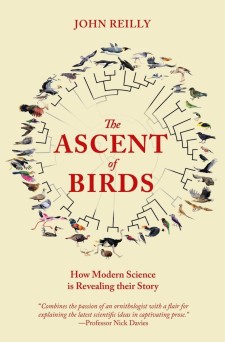Reviewed by Grant McCreary on March 7th, 2019.
Birds draw you in with flashy characteristics – dazzling colors, melodious songs, the power of flight. By the time you start to get inured to these you discover there is so much more. What’s the deal with all their diversity? Where did they come from? And just how in the world did we ever get such creatures as the birds-of-paradise? But such answers have not always been easy to come by, unless you happened to be an evolutionary biologist. That is, until John Reilly’s The Ascent of Birds: How Modern Science Is Revealing Their Story.
You would be forgiven for prejudging a book dealing with “the evolution of modern birds from their origins in Gondwana, over 100 million years ago, to the present day” would be a slog to read. But nothing could be further from the truth. The key is the final word in this book’s subtitle: story. This isn’t a textbook, it’s the story of birds.
Reilly divides The Ascent of Birds into self-contained chapters, each dealing with one group of birds and a specific evolutionary mechanism. The first chapter, The Tinamou’s Story: Death of a Paradigm, for example, introduces concepts such as neoteny, palaeognaths, and vicariance. Twenty-seven relatively short chapters in all deal with birds such as penguins, Hoatzin, hummingbirds, bowerbirds, sparrows, and tanagers, along with concepts including speciation, dispersal, sexual selection, and supertramps (yes, supertramps).
I can’t do justice to all the fascinating things you will learn in this book, so I’ll use one that really interested me as an illustration. As many North American birders are aware, what we know today as the Red Crossbill may not be just one species, but is likely a complex of several cryptic species – as many as nine. The frustrating thing for birders is that, apart from differences in bill size indiscernible in the field, they all look alike! But you can tell them apart by their flight calls. As a birder who wants to be sure of what crossbill type he’s looking at in order to be prepared for any future split, I was so focused on how to tell their calls apart that I never thought to wonder why, of all their possible characteristics, their flight calls would differ.
Reilly reports on research that suggests the differentiation of crossbill flight calls goes together with refinements in their bill size. The size of the bill makes it more efficient to open a certain type of cone. Birds with the similar bills will flock together, cooperating to find the appropriate trees with a minimum energy expenditure. They use calls in order to stay together and communicate. Thus, it makes sense that birds with the same bill size will evolve a flight call that would differentiate them from other crossbills. This leads to assortative mating, with birds of the same type breeding with each other instead of with other types even though their range may overlap, which in turn leads to new species of crossbills.
The stories are important, but how they are told is even more crucial. Reilly takes a complicated topic and perfectly walks a tight-rope by making it accessible while not dumbing it down. Even more surprising, he’s made it captivating reading!
That’s not to say that you won’t have to avail yourself of the glossary every so often. Sentences such as “…passerine phylogenetic relationships show a biogeographical pattern with a clear Gondwanan signature” may have you looking up terms that had been introduced in earlier chapters.
Recommendation
The Ascent of Birds: How Modern Science Is Revealing Their Story will answer questions you never knew you had about birds. It’s simply one of the best ornithological books for the layperson around, and my favorite bird book of 2018.
Disclosure: I get a small commission for purchases made through links in this post.
Buy from NHBS
(based in the U.K.)
Disclosure: The item reviewed here was a complementary review copy provided by the publisher. But the opinion expressed here is my own, it has not been influenced in any way.




Comment